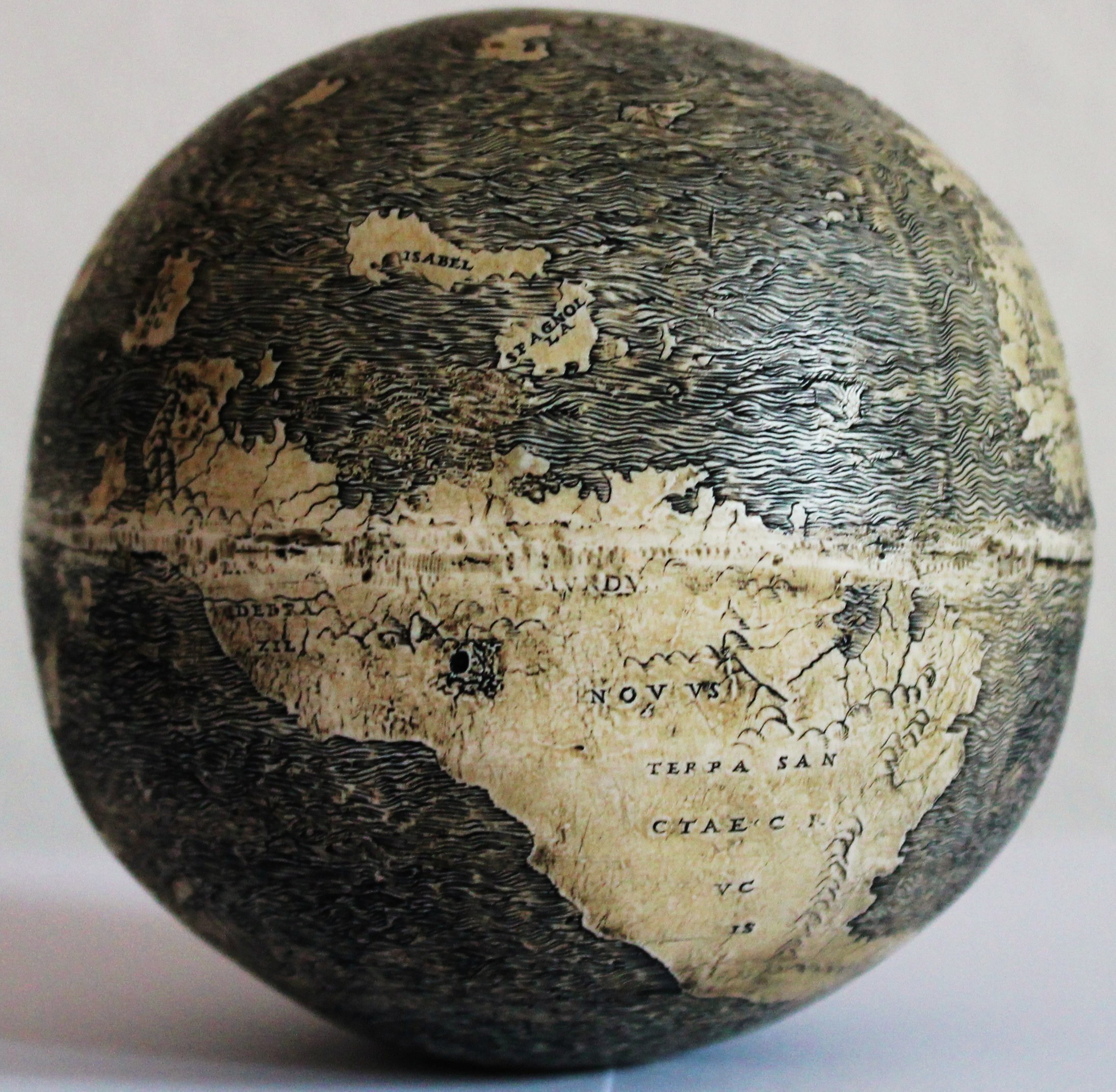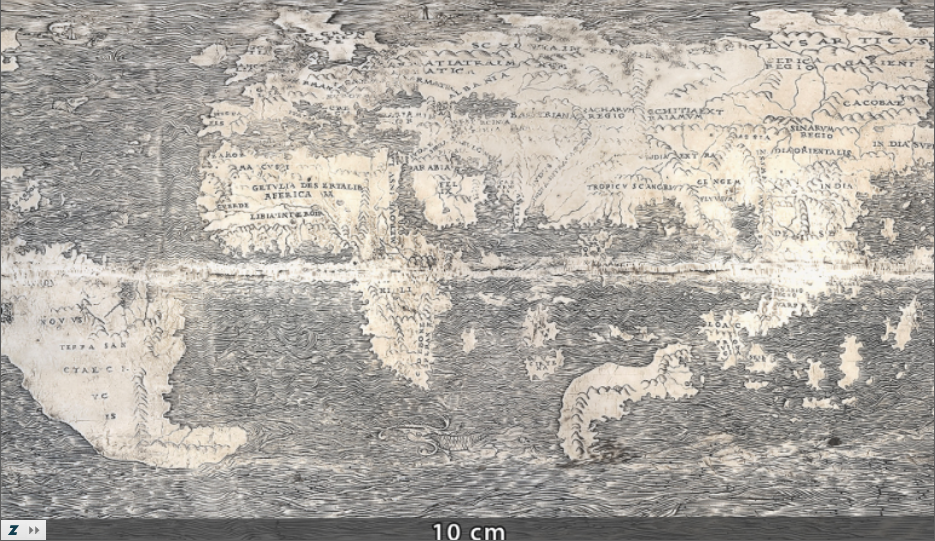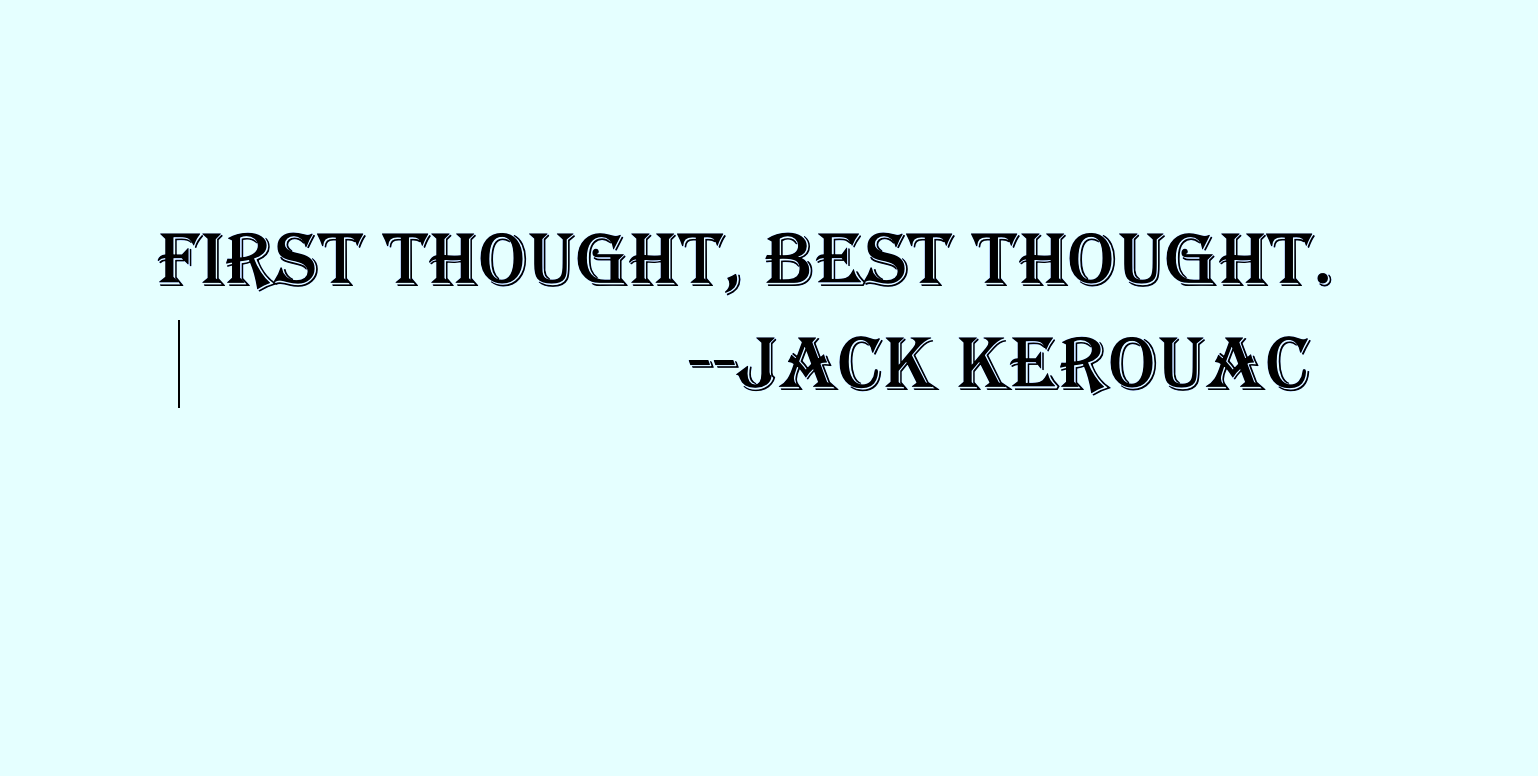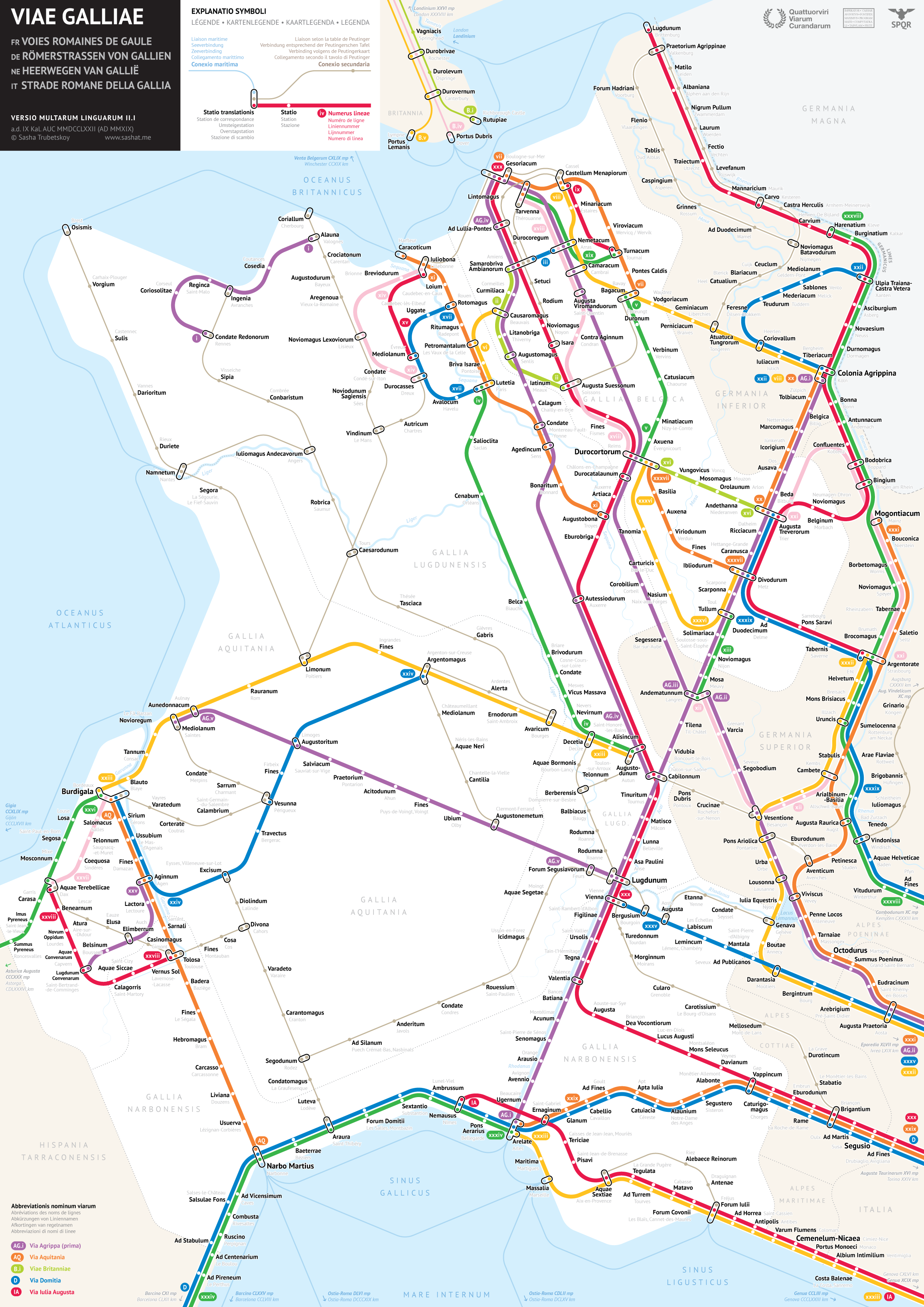[Most Recent Entries] [Calendar View]
Tuesday, February 23rd, 2021
- “In genius we perceive our own rejected thoughts, returning to us with a kind of alienated majesty.” — Ralph Waldo Emerson
- Simplicity is not an end in art, but we usually arrive at simplicity as we approach the true sense of things.” — Constantin Brâncu?i
- The first and most obvious characteristic of fiction is that it deals with reality through what can be seen, heard, smelt, tasted, and touched.” ? Flannery O’Connor
- “Writing, ideally, is recognizing your bad writing.” — August Wilson
- “One is always seeking the touchstone that will dissolve one’s deficiencies as a person and as a craftsman. And one is always bumping up against the fact that there is none except hard work, concentration, and continued application.” — Paul William Gallico
- “But what is art, really, but a good instinct for staying alive in your own alley?” — Hunter S. Thompson
- There is a microscopically thin line between being brilliantly creative and acting like the most gigantic idiot on earth. — Cynthia Heimel
- “A writer is a person for whom writing is more difficult than it is for other people.” — Thomas Mann
- “I learned never to empty the well of my writing, but always to stop when there was still something there in the deep part of the well, and let it refill at night from the springs that fed it.” — Ernest Hemingway
- “First thought best thought.” — Jack Kerouac
- “The job boils down to two things: paying attention to how the real people around you behave and then telling the truth about what you see.” — Stephen King
- “The important thing is that there should be a space of time, say four hours a day at least, when a professional writer doesn’t do anything else but write. He doesn’t have to write, and if he doesn’t feel like it, he shouldn’t try. He can look out of the window or stand on his head or writhe on the floor. But he is not to do any other positive thing, not read, write letters, glance at magazines, or write checks. Write or nothing.” — Raymond Chandler
- “I know this, with a sure and certain knowledge: a man’s work is nothing but this slow trek to rediscover, through the detours of art, those two or three great and simple images in whose presence his heart first opened.” — Albert Camus
- “Don’t look back.” – Bob Dylan
| Time | Event |
| 8:18a | Bruce Springsteen & Barack Obama Release a New Podcast, “Renegades: Born in the USA” Yesterday, Barack Obama and Bruce Springsteen unveiled the first two episodes of an 8-part podcast called “Renegades: Born In The USA.” The podcast (available on Spotify) is “a series of conversations between President Barack Obama and Bruce Springsteen about their lives, music, and enduring love of America—despite all its challenges.” The conversations were taped at Springsteen’s home between July and December of 2020. To hear the episodes, you will seemingly need to create a Spotify account, if you don’t have one already. Would you like to support the mission of Open Culture? Please consider making a donation to our site. It’s hard to rely 100% on ads, and your contributions will help us continue providing the best free cultural and educational materials to learners everywhere. Also consider following Open Culture on Facebook and Twitter and sharing intelligent media with your friends. Or sign up for our daily email and get a daily dose of Open Culture in your inbox. Related Content: The 150 Best Podcasts to Enrich Your Mind President Obama Names His Favorite Books, Movies & Songs of 2018 Bruce Springsteen & Barack Obama Release a New Podcast, “Renegades: Born in the USA” is a post from: Open Culture. Follow us on Facebook, Twitter, and Google Plus, or get our Daily Email. And don't miss our big collections of Free Online Courses, Free Online Movies, Free eBooks, Free Audio Books, Free Foreign Language Lessons, and MOOCs. |
| 12:00p | The Oldest Known Globe to Depict the New World Was Engraved on an Ostrich Egg, Maybe by Leondardo da Vinci (1504)
Image by Davidguam via Wikimedia Commons Every time you think you’ve got a handle on Leonardo da Vinci’s genius (which is to say, you think you’ve heard about the most important things he painted, wrote, and invented), yet more evidence comes to light of the many ways he meets the standard for the adjective “genius”…. Recently, Leonardo re-appeared not only as an inventor of futuristic military technology or discoverer of complex human anatomy, but also as the first European to depict the “New World” on a globe–proving he knew about Columbus’ voyages when the globe was made in 1504. The discovery “marks the first time ever that the names of countries such as Brazil, Germania, Arabia and Judea have appeared on a globe,” notes Cambridge Scholars Publishing, who released a book by the globe’s discoverer and primary researcher, Stefaan Missinne. The artifact attributed to Leonardo is engraved, “with immaculate detail,” writes Meeri Kim at The Washington Post, “on two conjoined halves of ostrich eggs.” And it features a single sentence, in Latin, above Southeast Asia: Hic Sunt Dracones–“Here be dragons.” We’ll notice other unique features of the engraved egg Missinne calls, simply, “the Da Vinci Globe,” such as the fact that in place of Central and North America are the islands of Columbus’ “discovery,” surrounded by a vast ocean in which Pacific and Atlantic join. Why ostrich eggs? Humans have used them for decorative purposes for millennia. Also, “in that time period,” says Thomas Sander, editor of the Washington Map Society’s journal, Portolan, “the ostrich was quite the animal, and it was a big thing for the noble people to have ostriches in their back gardens.” Missinne, a real estate developer, collector, and globe expert originally from Belgium, discovered the globe in 2012 at the London Map Fair. It was purchased “from a dealer who said it had been part of an important European collection for decades,” and its buyer and owner remain anonymous. After the globe appeared, Missinne “consulted more than 100 scholars and experts in his year-long analysis,” putting “about five years of research into one year,” says Sander, calling the research “an incredible detective story.”
Missinne’s investigation seems to substantiate his claims that the globe was made by Leonardo or his workshop. The evidence, some of which you can find on the Cambridge Scholars Publishing site, includes a 1503 preparatory map in da Vinci’s papers; the presence of arsenic, which only Leonardo was known to use at the time in copper to keep it from losing its lustre; “The use of chiaroscuro, pentienti, triangular shapes, the mathematics of the scale reflecting Leonardo’s written dimension of planet earth”; and a 1504 letter from Leonardo himself stating, “my world globe I want returned back from my friend Giovanni Benci.” Missinne and Geert Verhoeven, of the Ludwig Boltzmann Institute for Archaeological Prospection & Virtual Archeology, have published a paper on the “unfolding” of Leonardo’s globe into the two-dimensional image above (see an interactive version here). “This miniature egg globe is not only the oldest extant engraved globe,” the authors write, “but it is also the oldest post-Columbian globe of the world and the first ever to depict Newfoundland and many other territories.” Previously, the Hunt-Lenox Globe, a small copper globe, was thought to be the oldest known such artifact. Dated to around 1510, this globe, Missinne discovered, is actually a copy made from a cast of the older, original ostrich-egg globe. Missinne’s findings have their detractors, including John W. Hessler of the Library of Congress, who claims Missinne himself is the anonymous owner of the globe, which raises issues of conflict of interest. “Where this thing comes from needs to be clarified,” says Renaissance cartography expert Chet Van Duzer of the John Carter Brown Library in Providence, R.I., though he adds, “It is an exciting discovery, no question.” Missinne’s claims for the egg’s provenance are more modest than his marketing. He “speculates,” writes Kim, “ the egg could have loose connections to the workshop of Leonardo da Vinci.” Hessler’s view is less equivocal: “The Leonardo connection is pure nonsense.” A layperson like Missinne, whatever his personal investment, might be inclined to overinterpret evidence or make tenuous connections a trained scholar would avoid. The many scholars he cites in support of his claims for the globe are also vulnerable to these charges, however, though to a lesser degree. What do we make of French Mona Lisa expert Pascal Cotte’s testimonial, “I hereby confirm the evidence of the left-handedness of the engravings on the Ostrich Egg Globe. As Leonardo was the only left-handed artist in his workshop, I hereby endorse the hypothesis of Leonardo da Vinci’s authorship”? As in all such academic debates, “Here be dragons.” Weigh the case in full in Missinne’s 2018 book, The Da Vinci Globe. Related Content: Leonardo da Vinci’s Elegant Studies of the Human Heart Were 500 Years Ahead of Their Time Leonardo da Vinci Draws Designs of Future War Machines: Tanks, Machine Guns & More Josh Jones is a writer and musician based in Durham, NC. Follow him at @jdmagness The Oldest Known Globe to Depict the New World Was Engraved on an Ostrich Egg, Maybe by Leondardo da Vinci (1504) is a post from: Open Culture. Follow us on Facebook, Twitter, and Google Plus, or get our Daily Email. And don't miss our big collections of Free Online Courses, Free Online Movies, Free eBooks, Free Audio Books, Free Foreign Language Lessons, and MOOCs. |
| 3:00p | Anthony Bourdain Talks About the Big Break That Changed His Life–at Age 44 In 1999, Anthony Bourdain’s career seemed to have stalled. While his “principal vocation remained his position as executive chef” at New York’s Les Halles, restless intelligence and wanderlust kept him looking for other opportunities. “He was 43 years old, rode hard and put up wet,” writes Elizabeth Nelson at The Ringer, “a recovering addict with a number of debts and a penchant for finding trouble in failing restaurants across the city.” He had fought for and won an undeniable measure of success, but he hardly seemed on the threshold of the major celebrity chefdom he would maintain until his death twenty years later in 2018. Then, “in the spring of 2000, his sublimated literary ambitions suddenly caught up with and then quickly surpassed his cooking.” Bourdain’s memoir Kitchen Confidential “became an immediate sensation,” introducing his iconoclasm, acerbic wit, and outrageous confessional style to millions of readers, who would soon become viewers of his try-anything travelogue series, A Cook’s Tour, No Reservations, The Layover, and Parts Unknown, as well as loyal readers of his subsequent books, and even fiction like as Gone Bamboo, a crime novel soon to become a TV series. How did Bourdain first get his winning personality before the masses? It all started with a 1999 New Yorker article called “Don’t Eat Before Reading This,” the predecessor to Kitchen Confidential and an essay that begins with what we might now recognize as a prototypically Bourdainian sentence: “Good food, good eating, is all about blood and organs, cruelty and decay.” In the interview clip above, from Bourdain’s final, 2017 interview with Fast Company, he talks about how the story led to his “huge break” just a couple days after it ran, when a Bloomsbury editor called with an offer of “the staggeringly high price of fifty thousand dollars to write a book.” Everyone who loves Bourdain’s writing—and who loved his generous, ecumenical culinary spirit—knows why Kitchen Confidential changed his life overnight, as he says. Yes, “food is pain,” as he writes in the book’s “First Course,” but also, “food is sex”—”the delights of Portuguese squid stew, of Wellfleet oysters on the halfshell, New England clam chowder, of greasy, wonderful, fire-red chorizo sausages, kale soup, and a night when the striped bass jumped right out of the water and onto Cape Cod’s dinner tables.” Bourdain’s prose lingers over every delight, preparing us for the escapades to come. In Kitchen Confidential, the exhaustion, “sheer weirdness,” and constant “threat of disaster,” that attend New York kitchen life (and life “inside the CIA”—the Culinary Institute of America, that is), becomes fleshed out with scenes of culinary decadence the likes of which most readers had never seen, smelled, or tasted. Fans craved more and more from the chef who wrote, in 1999, just before he would become a bestselling household name, “my career has taken an eerily appropriate turn: these days, I’m the chef de cuisine of a much loved, old-school French brasserie/bistro where… every part of the animal—hooves, snout, cheeks, skin, and organs—is avidly and appreciatively prepared and consumed.” Read Bourdain’s New Yorker essay here and see his full 2017 interview with Fast Company just above. via @Yoh31 Related Content: Michael Pollan Explains How Cooking Can Change Your Life; Recommends Cooking Books, Videos & Recipes Josh Jones is a writer and musician based in Durham, NC. Follow him at @jdmagness Anthony Bourdain Talks About the Big Break That Changed His Life–at Age 44 is a post from: Open Culture. Follow us on Facebook, Twitter, and Google Plus, or get our Daily Email. And don't miss our big collections of Free Online Courses, Free Online Movies, Free eBooks, Free Audio Books, Free Foreign Language Lessons, and MOOCs. |
| 5:00p | The 69 Pages of Writing Advice Denis Johnson Collected from Flannery O’Connor, Jack Kerouac, Stephen King, Hunter Thompson, Werner Herzog & Many Others
The internet is full of inspirational quotations about writing, many of them from accomplished and respectable writers. But what need could such writers have of inspirational quotations themselves? Surely true literary art flows from its authors without need of encouraging words, demand though it may sustained periods of labor, frustration, and even suffering. These days, more than a few who seek to create such art spend time studying not just its past masterworks but its living masters. “Some years ago,” the novelist Karan Mahajan recently tweeted, “I was lucky to take a class with Denis Johnson, who dressed like a card-shark, in flashy jackets and (unlike a card-shark) wept over sentences. He gave my class a 69-page list of writing quotes he returned to frequently.” Johnson’s list, which you can see in PDF form here, shows that at least one of our era’s most celebrated writers swore by the kind of writing advice most of us scroll past every day. Though somewhat eccentrically formatted, it rounds up a great deal of valuable wisdom from novelists, poets, and playwrights — as well as philosophers, sculptors, filmmakers, and other figures besides — from different lands and different times. In it you’ll find these reflections on the art, craft, and life of writing, among many others: Over the course of these 69 pages, certain themes emerge: the importance of writing with one’s “blood,” the unimportance of critics, the value of simplicity, the danger of adjectives (and other excess description), the necessity of letting nothing block the flow of the first draft. While many of these quotations offer practical advice — much of it about consistently putting in the hours, both conscious and unconscious — some approach from a more oblique angle not just “writing” as a pursuit but the living of life itself. “To fail to embrace my dreams now would be a disgrace so great that sin itself could not find a name for it,” writes Werner Herzog in the diary he kept during the agonized making of Fitzcarraldo. If this inspired the author of Jesus’ Son and Tree of Smoke, it ought to inspire the rest of us as well. Related Content: 19 Quotes on Writing by Gore Vidal. Some Witty, Some Acerbic, Many Spot On Stephen King’s 20 Rules for Writers Kurt Vonnegut’s Eight Tips on How to Write a Good Short Story 7 Tips From Ernest Hemingway on How to Write Fiction Write Only 500 Words Per Day and Publish 50+ Books: Graham Greene’s Writing Method Based in Seoul, Colin Marshall writes and broadcasts on cities, language, and culture. His projects include the Substack newsletter Books on Cities, the book The Stateless City: a Walk through 21st-Century Los Angeles and the video series The City in Cinema. Follow him on Twitter at @colinmarshall or on Facebook. The 69 Pages of Writing Advice Denis Johnson Collected from Flannery O’Connor, Jack Kerouac, Stephen King, Hunter Thompson, Werner Herzog & Many Others is a post from: Open Culture. Follow us on Facebook, Twitter, and Google Plus, or get our Daily Email. And don't miss our big collections of Free Online Courses, Free Online Movies, Free eBooks, Free Audio Books, Free Foreign Language Lessons, and MOOCs. |
| 8:00p | The Roman Roads of Gaul Visualized as a Modern Subway Map
At a casual glance, some travelers may take the map above for a depiction of France’s enviable intercity high-speed rail network Train à Grande Vitesse, better known as TGV. In reality, its content predates that system’s inauguration in the early 1980s — and by nearly two millennia at that. This is in fact a map of Gaul, a region of Europe that, most broadly defined, included modern-day France, Luxembourg, and Belgium, as well as parts of Switzerland, Italy, the Netherlands, and Germany. Ruled by Rome for five centuries until the fall of the Roman Empire itself, Gaul was run through with a number of Roman roads, a subject of fascination for many archaeologically inclined historians. They’ve also become a subject of fascination for a young data scientist and graphic designer by the name of Sasha Trubetskoy. His work, much featured here on Open Culture, includes maps of the Roman Roads of Britain, Italy, Spain and Portugal, as well as, at a larger scale, those of the entire empire. “This was an interesting map to make, but I can’t say it was fun all the time,” writes Trubetskoy. “Generally I enjoyed the process, but it was far more challenging than I had anticipated.” You can hear him describe some of the challenges involved, and even show how solving them played out in his design process, in his three-hour explanatory live stream now archived on Youtube. You can download Trubetskoy’s Roman Roads of Gaul map from his site, and even buy a high-resolution file suitable for printing as a poster (USD $9). “As far as I can tell, it’s done,” writes Trubetskoy of the work, wisely — or from frustrating personal experience — acknowledging that, despite or because of the centuries of distance between us and the relevant historical and geographical facts, those facts could still change. Just as ancient history cannot both make its way to us and maintain absolutely perfect fidelity to the past, so the kind of practical visual design embodied in a subway map necessitates a great deal of simplification and approximation to be useful. And speaking of the graphic arts, just imagine how useful this particular map would’ve been to Asterix. Related Content: Ancient Rome’s System of Roads Visualized in the Style of Modern Subway Maps The Roman Roads of Britain Visualized as a Subway Map All the Roman Roads of Italy, Visualized as a Modern Subway Map Based in Seoul, Colin Marshall writes and broadcasts on cities, language, and culture. His projects include the Substack newsletter Books on Cities, the book The Stateless City: a Walk through 21st-Century Los Angeles and the video series The City in Cinema. Follow him on Twitter at @colinmarshall or on Facebook. The Roman Roads of Gaul Visualized as a Modern Subway Map is a post from: Open Culture. Follow us on Facebook, Twitter, and Google Plus, or get our Daily Email. And don't miss our big collections of Free Online Courses, Free Online Movies, Free eBooks, Free Audio Books, Free Foreign Language Lessons, and MOOCs. |
| << Previous Day |
2021/02/23 [Calendar] |
Next Day >> |





